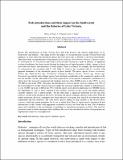| dc.description.abstract | Recent fish introductions in Lake Victoria have had both positive and adverse implications on its
biodiversity and fisheries. This paper reviews the impact of six introductions in Lake Victoria basin with
emphasis on areas where the introduced species have put more risks or benefits to the host environments.
There have been six introductions of fish species (Lates niloticus, Oreochromis niloticus, Cyprinus carpio,
O. melanopleura, O. leucostictus and Tilapia zillii) in Lake Victoria in a span of 20years. A significant
ecological imbalance has been created through the depression of haplochromiine cichlids, changes in food
webs and food chains, and alterations of water quality. There is evidence for example, that the introduced
O. melanopleura has crossbred with T. zillii while O. niloticus has crossbred with O. variabilis with
apparent dominance of the introduced species in these hybrids. The native species (Labeo victorianus,
Barbus spp, Haplochromis spp., Protopterus aethiopicus, Bagrus docmac, Clarias spp, Alestes spp,
Synodontis spp and the native tilapia species) have declined considerably in the commercial catches in the
last few decades. On the other hand, it has been a great boost to the riparian communities, and Kenya as a
whole from the increased commercial fish landings from less than 20,000 m.tons in the 1970’s to over
193,000 m. tons in the 1990’s. Presently, the introduced L. niloticus and O. niloticus compose over 70% of
the total landings by weight. Fish protein food supply has increased significantly; number of fishermen now
is over 36,000 (up from 11,000 in the 1971) with the export sector directly employing over 500,000. Given
the dependants as well as those engaged in the auxiliary activities in this sector, the fishing industry
currently supports over 1 million people. On the other hand, a significant nutritional loss has also been
noted as a result in the decline in the local’s favourite fish species (endemic species) in the catch. With the
market expansion, the local community have been reduced to low-grade fish, which do not meet the export
requirement and fish skeletons. The only native species landed in large quantity is the Rastrineobola
argentea, which has gained popularity for its use as animal feed. There is urgent need to document all fish
introductions in this country with appropriate evaluation of each case from time to time. This evaluation
report will contribute to the development of guidelines to introduction programs in future. The need for
research in order to better anticipate with confidence the cost of any introductions before such programs are
implemented cannot be overemphasised. | en_US |

